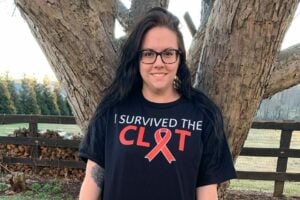In 2014, while in podiatry school, I went to the student health center because I was short of breath and was coughing up blood. The nurse practitioner diagnosed me with bronchitis.
Less than two weeks later, I learned the truth — I had a saddle pulmonary embolism, which means a large blood clot was blocking blood flow to both sides of my lungs. The clot was caused by birth control pills, along with other risk factors like recent travel and my weight.
I needed emergency treatment, including procedure called a mechanical thrombectomy to remove the clot from my leg and a catheter-directed thrombolysis to treat the one in my lungs. I also had part of my lung damaged by the clot, called a pulmonary infarction.
I was on a blood thinner, rivaroxaban, for six months after this incident and I have done well since then. I delivered a healthy baby boy in 2023 and took daily blood thinning injections (enoxaparin) without any issues.
I was recently traveling and developed another blood clot in my leg (DVT). As a result, I will need to take blood thinners for life and I am okay with that. I am grateful to be alive.
As a physician, I am more aware of looking for the signs and symptoms of blood clots in my patients. If someone has symptoms that make me suspect a DVT, I don’t hesitate to order an ultrasound to check for it.
I enjoy looking at NBCA’s Instagram page and knowing I am not alone in this battle. There are a lot of people like me and I feel extremely grateful that I made it out alive.
My advice is to listen to your body. You know your body better than anyone else. If you feel the symptoms and are concerned, get checked out.
Resources
What is a PE?
Living Your Best Life on Blood Thinners
Know Your Risk




